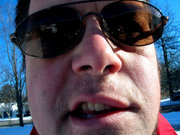* Photocopy for your patients "Bell's palsy" on page 160.
* EVIDENCE-BASED ANSWER
Early use of corticosteroid therapy results in less autonomic synkinesis and possibly improved rates of recovery in adults (strength of recommendation: C); there is no proven benefit in children (SOR: B).
Adding acyclovir (Zovirax) to prednisone therapy may improve recovery rates compared with prednisone alone (SOR: C).
The results of 1 nonblinded study indicate that intramuscular methylcobalamin (vitamin [B.sub.12]) used alone or in combination with prednisone may shorten time to recovery (SOR: C).
* EVIDENCE SUMMARY
Bell's palsy is a lower motor neuron disease of the facial nerve characterized by a transient paralysis. Healing is occasionally incomplete, resulting in residual nerve dysfunction, including partial palsy and motor synkinesis (involuntary movement accompanying a voluntary one) and autonomic synkinesis (involuntary lacrimation after a voluntary muscle movement). Bell's palsy is associated with significant edema and ischemia of the facial nerve as it passes through its bony canal.
Herpes simplex reactivation has been shown to be associated with a large proportion of cases.
Corticosteroids are the most studied form of therapy for Bell's palsy (Table). Early work in England culminated in 1971 with a well-performed study demonstrating lower rates of incomplete recovery with prednisolone compared with corticotropkin. (1) A potentially definitive randomized controlled trial in 1970 was stopped prematurely because of investigators' subjective impression that prednisone markedly reduced postauricular pain. (2) Subsequently, the highest-quality study had few patients (n=51) and reported no difference in outcomes between patients receiving 10 days of oral prednisone plus vitamins and those receiving vitamins alone. (3)
One open randomized controlled trial demonstrated shorter mean recovery times with intramuscular methylcobalamin (1.95 weeks) and methylcobalamin plus prednisone (2.0 weeks) compared with prednisone alone (9.6 weeks). (4) Another trial of 239 patients showed improved rates of autonomic synkinesis after treatment with 16 days of prednisone compared with placebo. (5)
A randomized, controlled trial of children 2 to 6 years of age found no significant differences in short-term recovery after treatment with methylprednisolone compared with untreated controls. (6) Eventually, all these children recovered normal facial nerve function within 12 months.
Two randomized controlled trials have assessed the efficacy of acyclovir for treatment of Bell's palsy. One trial compared prednisone with acyclovir and found patients treated with prednisone had better complete recovery rates, 93.6% versus 77.7% (absolute risk reduction [ARR]=15.9%, 95% confidence interval [CI]=2.8%-29%], number needed to treat [NNT]=7). (7)
Another study demonstrated that the combination of prednisone and acyclovir had greater complete recovery rates compared with prednisone alone (92% vs. 76%, ARR=16%, 95% CI=1.7%-30.3%, NNT=7). (8)
Overall, the data suggest corticosteroid therapy may provide a small clinical benefit in adult patients with Bell's palsy. In many of these studies, patients who had contraindications to steroid therapy (peptic ulcer disease, uncontrolled diabetes, hypertension, or immunosuppression) were excluded.
If no contraindications to steroids exist, it is resonable to initiate treatment with corticosteroids for an adult patient with new-onset Bell's palsy. Most studies have started patients on steroids within 10 days of onset of symptoms.
* RECOMMENDATIONS FROM OTHERS
A practice parameter from the American Academy of Neurology states that steroids are safe and probably effective (SOR: B), whereas acyclovir is safe and possibly effective (SOR: C). (9) Systematic reviews from the Cochrane Database report that available evidence from randomized controlled trials does not show significant benefit from treating Bell's palsy with corticosteroids and that clinical trials on acyclovir are inconclusive and therefore cannot be used to make recommendations regarding its use. (10,11)
* CLINICAL COMMENTARY
My practice of neurology began before the era of corticosteroid treatment for Bell's palsy. Despite the lack of convincing evidenced-based data, it is my clinical impression that there are far fewer patients today with incompletely resolved Bell's palsy than before the widespread use of steroids. Permanent facial deformities seemed more common back then. Therefore, in the absence of harmful effects, I will continue treating with steroids.
Steven H. Horowitz, MD, University of Vermont College of Medicine, Burlington.
REFERENCES
(1.) Taverner D, Cohen SB, Hutchinson BC. Comparison of corticotrophin and prednisolone in treatment of idiopathic facial paralysis (Bell's palsy). Br Med J 1971; 4:20-2.
(2.) Adour KK, Wingerd J, Bell DN, Manning JJ, Hurley JP. Prednisone treatment for idiopathic facial paralysis (Bell's palsy). N Engl J Med 1972; 287:1268-72.
(3.) May M, Wette R, Hardin WB, Jr., Sullivan J. The use of steroids in Bell's palsy: a prospective controlled study. Laryngoscope 1976; 86:1111-22.
(4.) Jalaludin MA. Methylcobalamin treatment of Bell's palsy. Methods Find Exp Clin Pharmacol 1995; 17:539-44.
(5.) Wolf SM, Wagner JH, Davidson S, Forsythe A. Treatment of Bell palsy with prednisone: a prospective, randomized study. Neurology 1978; 28:158-61.
(6.) Unuvar E, Oguz F, Sidal M, Kilic A. Corticosteroid treatment of childhood Bell's palsy. Pediatr Neurol 1999; 21:814-6.
(7.) De Diego JI, Prim MP, De Sarria MJ, Madero R, Gavilan J. Idiopathic facial paralysis: a randomized, prospective, and controlled study using single-dose prednisone versus acyclovir three times daily. Laryngoscope 1998; 108:573-5.
(8.) Adour KK, Rubayaines JM; Von Doersten PG, Byl FM, Trent CS, Quesenberry CP Jr. et al. Bell's palsy treatment with acyclovir and prednisone compared with prednisone alone: a double-blind, randomized, controlled trial. Ann Otol Rhinol Laryngol 1996; 105:371-8.
(9.) Grogan PM. Gronseth GS. Practice parameter: Steroids, acyclovir, and surgery for Bell's palsy (an evidence-based review). Report of the Quality Standards Subcommittee of the American Academy of Neurology. Neurology 2001; 56:830 6.
(10.) Salinas RA, Alvarez G, Alvarez MI, Ferreira J. Corticosteroids for Bell's palsy (idiopathic facial paralysis) (Cochrane Review). In: The Cochrane Library, Issue 2, 2002. Oxford: Update Software. Updated quarterly.
(11.) Sipe J, Dunn L. Aciclovir for Bell's palsy (idiopathic facial paralysis) (Cochrane Review). In: The Cochrane Library, Issue 2, 2002. Oxford: Update Software. Updated quarterly.
Scott Shannon, MD, Dept of Family and Community Medicine University of Missouri, Columbia. E-mail: shannons@health.missouri.edu. Susan Meadows, MLS, Dept of Family and Community Medicine, University of Missouri, Columbia. E-mail: meadowss@health.missouri.edu.
COPYRIGHT 2003 Dowden Health Media, Inc.
COPYRIGHT 2003 Gale Group



